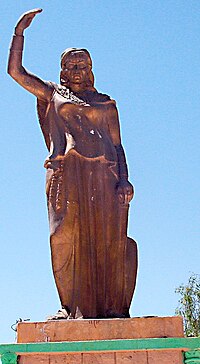Kāhina

Dihya ( tamazight ⴷⵉⵀⵢⴰ Dihya , "beautiful gazelle", Arabic الكاهنة) the Kāhina ("priestess", derived from Kohanim ) (died 701) was a Berber queen and a religious and military leader who led the resistance of the North African natives against the Arab conquest of the Maghreb .
Note to reception
Numerous reports by the Arabs and Berbers, and also the Berber genealogies in particular, were based on oral tradition in their time and were quickly distorted as legends or propaganda. In the earliest cases, these reports were written a century after her death; other legends did not exist until many centuries later. That is why many of the statements are doubtful, as was the case with her predecessor as Berber leader, the alleged Berber Christian Kusaila . There are reports that al-Kahina was a Jewish Berber, but also that she persecuted Jews as well as Muslims. In addition to such religiously colored depictions, there are also feminist or nationalistic depictions of her life; Depending on the narrative, with her in a positive or negative role. Accordingly, to this day she is admired by Berbers and anti-Arab nationalists, but is known by Arabs more as a fighter against Muslims and as a malicious witch.
Life
Her birth name was Dihya (also: Daya, Damya, Dahyia), which means “beautiful gazelle” in Tamazigh (Berber language), while the name Kahina in Arabic stands for a fortune teller , but also a priestess (probably derived from Kohanim , like the Jewish historical narrative on the Kahina suggests).
She is said to have been the daughter of Tabetta (also: Tabat), the eighth ruler of her tribe. Kahina was the leader of the Berber tribe of the Jarawa (also: Jarawa, Jeruarer) in the Aurès ( Zanata ). She is said to have had at least two sons from relationships with a Byzantine and a Berber. The Jarawa are said to have converted to a (nomadic alienated) Judaism as early as late antiquity , like many other Berber tribes in North Africa. Al-Kahina was believed by all sources to be able to see into the future, which in Hoffer's opinion was a self-promoted claim, while in fact she had a good information network.
After Kusaila ibn Lemzem had previously led the resistance against the Muslims under Hassan ibn an-Numan in Ifrīqiya and had fallen around 688, al-Kahina subsequently asserted herself as the leader of the Berbers until 695. While the Muslims were able to subdue the coastal regions without any problems, the Berber resistance began with the Muslim advance into the hinterland. Al-Kahina switched to the "scorched earth tactic" and was able to force the Muslims to withdraw from Ifriqiya after a victory on Nin. After this victory at the latest, al-Kahina was recognized by the Berbers as army leader and queen.
Some Muslim prisoners are said to have been released. Chalid ibn Yazid al-Qaisi, probably a relative of ibn an-Numans, was adopted by al-Kahina as the third son. This adoption is said to have been her undoing, because according to some reports she was betrayed by this adopted son at a time of domestic political weakness: Opposition Berbers were tired of using the scorched earth tactics in every battle and sacrificing everything for victory; also, according to Ibn Chaldūn , she is said to have ruled despotic.
In a new attack by the Muslims under ibn an-Numan, who knew about the weakening solidarity among the Berbers, al-Kahina was defeated near Taharqa (701). Supporters of the Berber opposition to al-Kahina then celebrated the Arab invaders as liberators.
The circumstances of your death cannot be determined with certainty. Some believe that she died in battle, but also that she killed herself with poison to avoid capture. Her biological sons either died with her or converted to Islam. With the death of al-Kahina, the common resistance of the Berbers ended. Further clashes between Berbers and Arabs took place under the banner of Islam .
Modern reception
- Author Manly Wade Wellmann wrote a historical fantasy novel about her called Cahena .
- In the TV series Relic Hunter - The Treasure Hunter (episode 64), the treasure hunters discover an artifact that is assigned to Kāhina. Kāhina can be seen in flashbacks in the episode.
- The TV series Xena - The Warrior Princess (episode Legacy) tells a fictional story about Kāhina (played by Alison Bruce ).
literature
- Gerda Hoffer : Dahiya Cahena. In: Time of the heroines. Life pictures of extraordinary Jewish women. Munich 1999, ISBN 3-423-30701-3 , pp. 13-25.
- Stephan and Nandy Ronart: Lexicon of the Arab World. Artemis Verlag, 1972, ISBN 3-7608-0138-2 .
Individual evidence
-
↑ a b c d e Gerda Hoffer: Time of the heroines. Pp. 13-25.
Regarding Hoffer's life picture of the Kahina, it should be noted that the author cites the available sources ( Ibn Chaldūn , Ibn ʿIdhārī , André Chouraqui 1960, Joachim Hirschberg 1974), but in her elaboration of the portrait also interprets them freely. - ↑ a b c Kahina . In: Ancient History Encyclopedia . ( ancient.eu [accessed August 2, 2018]).
- ↑ Africa Junior - ScalaZ. Retrieved August 2, 2018 .
| personal data | |
|---|---|
| SURNAME | Kāhina |
| ALTERNATIVE NAMES | Dihya; Damja; Daya; Dahyia Cahena |
| BRIEF DESCRIPTION | Berber leader in the fight against Muslims |
| DATE OF BIRTH | 7th century |
| DATE OF DEATH | 701 |